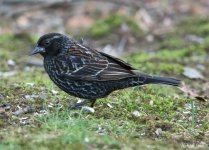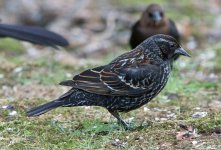Wouldn't this be awfully early for an immature Red-winged Blackbird in Massachusetts? Birds of North America online suggests that they should only be nest building in late April in the Northeast. Why isn't this an adult female?
Because a female is a very different animal - much browner, with a wide, pale supercilium, thin malar, and lots of buff to peachy suffusion to the face. Looks like
this. Note also how the breast and belly are more 'dark streaks on white' rather than the reverse.
This is a bit odd, though - I've seen lots of Red-winged Blackbirds, early in the year (thanks to banding operations I've worked on), and I have never seen one that looks quite like this. Usually, the immature (or, as I prefer, SY*) males have a fair amount of pale edging to the plumage, and their epaulets are not so red as the "definitive" males, but they aren't like this. This one looks like a male that has retained a lot more of the juvenile plumage than it had any right to. I really can't explain that part. Still, I remain confident that it's a male.
Peter C.
*Here we encounter the reason why I'm always harping on to people (not on Birdforum, so much, but elsewhere) about the importance of being careful with terminology. Immature is a bit of a fuzzy word - when speaking of bird moult, it can mean different things to different people. How old does a bird have to be, before it is no longer an 'immature'? Depends on the species...
But what you mean by this, I gather from context, is what I would call "juvenile" - fledged, fully-feathered, but not "adult". But this is not (at least I don't imagine) what KC meant back in post #2 - in the context of spring songbirds, immature means "born last year", i.e. has only gone through one pre-basic moult (which would have happened last fall). This plumage is what I would call 'second year' or just SY. Lots of passerines have an SY plumage that is virtually indistinguishable from the "definitive" adult (or, ASY) plumage - e.g. most sparrows, many warblers, etc. A few, though, show obvious differences between second-year and subsequent years - such as male American Redstarts, and this species.
I can't recall, off the top of my head, just how much of a moult (if any) that Red-wingeds have in spring, but that may influence what the birds look like in early spring.







